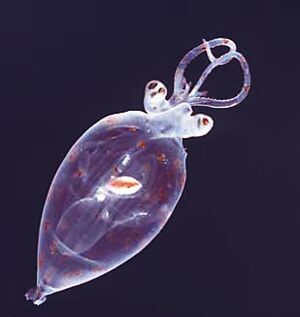Decapodiformes facts for kids
Quick facts for kids Decapodiformes |
|
|---|---|
 |
|
| Young cephalopod from plankton, Antarctica | |
| Scientific classification |
|
| Kingdom: | Animalia |
| Phylum: | Mollusca |
| Class: | Cephalopoda |
| (unranked): | Neocoleoidea |
| Superorder: | Decapodiformes Leach, 1817 |
| Orders | |
|
See text |
|
| Synonyms | |
|
|
Decapodiformes are a special group of cephalopods. Cephalopods are amazing ocean animals like squid, octopuses, and cuttlefish. What makes Decapodiformes unique is that they all have ten "limbs." These limbs are usually eight shorter arms and two longer tentacles.
Scientists believe that the very first cephalopods had five pairs of similar limbs. Over a long time, some of these animals changed. One group developed a special pair of limbs (their fourth pair) into the long tentacles we see today. These became the Decapodiformes. Another group lost one pair of limbs (their second pair) and became the Octopodiformes, which are octopuses, known for having eight arms.
What Are Decapodiformes?
Decapodiformes are a "superorder," which is a big group in the animal kingdom. It includes many different kinds of cephalopods that share the common feature of having ten limbs. These animals live all over the world's oceans, from shallow coastal waters to the deep sea.
Types of Decapodiformes
There are several different groups, called "orders," within the Decapodiformes superorder. Some of these groups are still alive today, while others are only known from fossils.
Here are some of the main orders of Decapodiformes:
- Bathyteuthida: These are deep-sea squid.
- †Belemnitida: These were ancient, extinct cephalopods that looked a bit like squid. The dagger (†) means they are no longer alive today.
- †Diplobelida: Another group of extinct cephalopods.
- Idiosepida: These are very tiny pygmy squid.
- Myopsida: This group includes many types of squid that live closer to the coast.
- Oegopsida: These are squid that live in the open ocean, far from the coast.
- Sepiida: This order includes cuttlefish, as well as pygmy, bobtail, and bottletail squid.
- Spirulida: This group includes the ram's horn squid, which has a unique internal shell shaped like a ram's horn.
See also
 In Spanish: Decapodiformes para niños
In Spanish: Decapodiformes para niños

